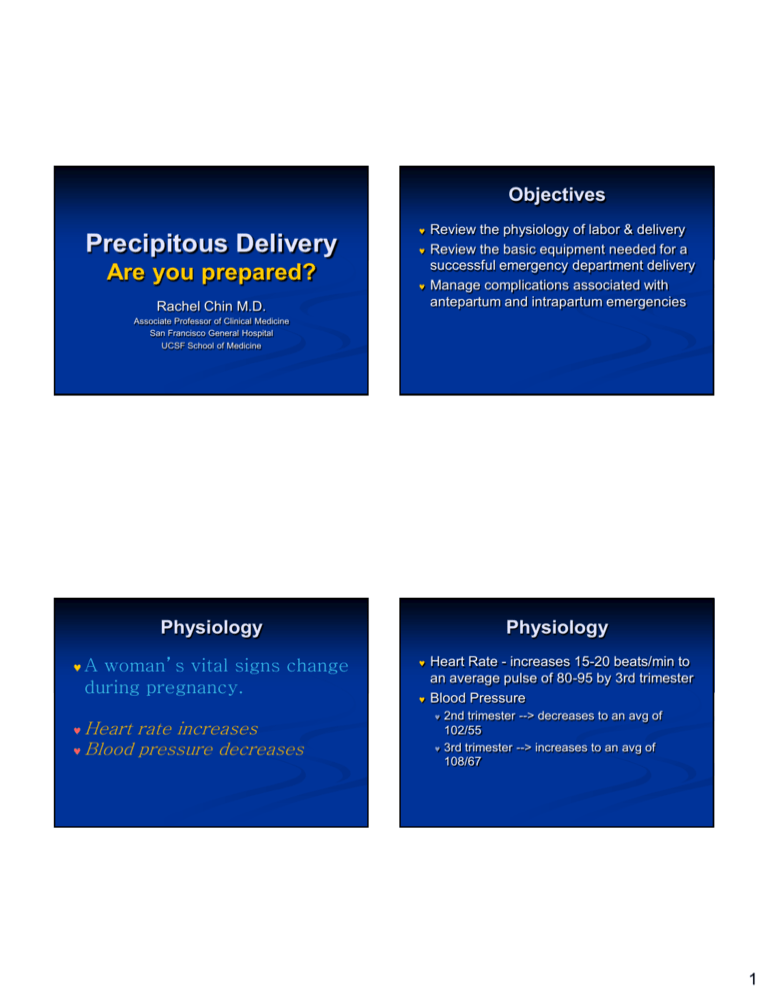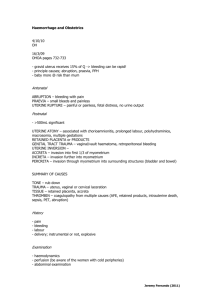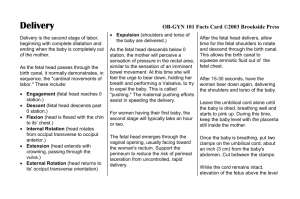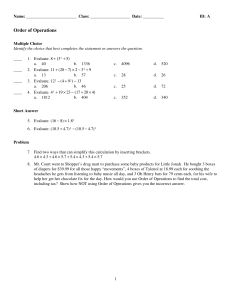Precipitous Delivery Are you prepared?
advertisement

Objectives Precipitous Delivery Are you prepared? Rachel Chin M.D. Review the physiology of labor & delivery Review the basic equipment needed for a successful emergency department delivery Manage complications associated with antepartum and intrapartum emergencies Associate Professor of Clinical Medicine San Francisco General Hospital UCSF School of Medicine Physiology A woman’s vital signs change during pregnancy. Heart rate increases Blood pressure decreases Physiology Heart Rate - increases 15-20 beats/min to an average pulse of 80-95 by 3rd trimester Blood Pressure 2nd trimester --> decreases to an avg of 102/55 3rd trimester --> increases to an avg of 108/67 1 Physiology Cardiac output increases 40% Stroke volume increases 25-30% Plasma volume increases 45-50% RBC mass increases 33% but not as fast as plasma volume What can possibly go wrong? Physiologic anemia Slight respiratory alkalosis PreEclampsia/Eclampsia Vaginal bleeding Pre-eclampsia Pre-eclampsia/Seizures (Eclampsia) Vaginal Bleeding Breech, Limb, Face delivery Meconium staining Premature delivery Antepartum Emergencies Placenta Previa, Abruption Prolapsed cord Malpresentation Hypertension after 24th week of gestation New onset or worsening of chronic HTN 5-7% of pregnancies Most often in first pregnancies Other risk factors include young mothers, no prenatal care, multiple gestation, lower socioeconomic status 2 Pre-eclampsia Triad Hypertension Proteinuria Edema Pre-eclampsia Etiology? “Disease of theories” Abnormal endothelial fxn-cytokines (i.e., tumor necrosis factor ) and endothelin-1 Preeclampsia-Searching for the Cause N Eng J Med 2004;350(7):641-642 Pre-eclampsia Signs and Symptoms Hypertension Systolic > 140 mm Hg Diastolic > 90mm Hg Or SBP > 30 mmHg or DBP > 15mmHg above patient’s baseline BP Pre-eclampsia Signs and Symptoms Proteinuria Edema (particularly of face) 1 + urine dip or >300 mg in 24 hrs Rapid weight gain >3lbs/wk in 2nd trimester >1lb/wk in 3rd trimester Decreased urine output Headache, blurred vision Nausea, vomiting RUQ or Epigastric pain 3 Pre-eclampsia Complications Eclampsia Abruption Pre-eclampsia Management Cerebral edema or stroke Renal failure Hemolytic anemia Thrombocytopenia Hepatic hematoma/hepatic failure Retinal damage Pulmonary edema IUGR Occurs in less than 1% of pregnancies Signs, symptoms of pre-eclampsia plus: Grand Consider if pre-term Lateral recumbent position Bedrest Lower blood pressure if SBP>170 or DBP>105 Betamethasone if <34wks gestation Eclampsia Labor induction if term Premature separation of placenta Eclampsia Complications Same as pre-eclampsia Maternal mortality rate: 10% Fetal mortality rate: 25% mal seizures Coma 4 Question 34 year old 35 week pregnant female with no PMH BIBA for seizures. Found down at home by husband, sz’ed twice in the ambulance. C/o HA & epigastric pain night prior. Paramedic report no head trauma but ecchymosis on chest and neck. VS: BP 200/116, HR 90, RR 16, 100% NRM, FHT 140’s. What do you do? What is the best anti-convulsive treatment for eclampsia? A. IV phenytoin B. IV diazepam C. IV magnesium sulfate How should we treat seizures? Eclampsia Magnesium sulfate > phenytoin or diazepam Management 100% O2; assist ventilations, as needed Left lateral recumbent position MgSO4 Collaborative Eclampsia Trial Lancet 1995 June 10;345:1455-63 6 gm IV bolus, then 2 gm/hr 10 gm IM if no IV access (5gm each buttock) Betamethasone if <34 weeks gestation 5 Magnesium sulfate Reduces risk of recurrent seizure, maternal mortality and neonatal morbidity Mechanisms: potent vasodilator (against vasospasm) and NMDA receptor antagonist (neuroprotection) “MgSO4” now on list of JCAHO-prohibited abbreviations Magnesium sulfate N Engl J Med 2003;348:2154-2155. Side Effects Drowsiness Flushing Diaphoresis Hyporeflexia Hypocalcemia 4g IV loading dose over 15 minutes then 1-2 g/hr infusion Maintain serum concentration 4-7 mg/dL (when serum level is not readily available, infusion should be titrated to maintain deep tendon reflexes) Maternal toxicity of magnesium is rare if drug is carefully administered & monitored Your patient has been admitted for eclampsia and is receiving magnesium sulfate at 2gm/hr. You assess that your pt’s respirations are 8 per min and you cannot elicit a reflex. What do you do? A. Discontinue magnesium & get a neurology consult. B. Discontinue magnesium and administer O2 C. Discontinue magnesium and give O2 and 1 gm calcium gluconate IV. 6 Toxicity Absent DTRs (deep tendon reflexes) Ataxia Pulmonary edema Respiratory paralysis Magnesium sulfate First warning of toxicity is loss of DTRs (812 mg/dl) Somnolence (10-12 mg/dl) Slurred Speech (10-12 mg/dl) Muscular paralysis (15-17 mg/dl) Respiratory difficulty (15-17 mgdl) Cardiac arrest (30-34 mg/dl) Antidote Calcium gluconate Calcium chloride- greater concentration Your eclamptic patient is approximately 2 hours out from her seizure. Labor induction is progressing successfully with cervix now 6 cm dilated. Her BP has been consistently elevated, with the last 2 readings approx 165/110. Your choice for antihypertensive therapy is: a. methyldopa (Aldomet) 500mg PO b. hydralazine 5 mg IV c. nifedipine 10 mg PO d. labetalol 20 mg IV Sibai BM, NEJM 1996;335(4):257-265 Treatment of Hypertension in Pregnancy 7 Hydralazine Arterial vasodilator 5 mg IV, then repeat 5 mg IV for 20 min up to 20 mg total dose IV infusion 5-10 mg/hr titrated Must wait 20 min for response between IV doses; possible maternal hypotension Labetalol Selective and nonselective antagonist 20 mg IV, then 40-80 mg IV for 10 minutes to 300 mg total dose IV infusion 1-2 mg/min titrated Less reflex tachycardia and hypotension than with hydralazine Abruption Abruption Premature separation of placenta from uterus High risk groups: Older pregnant patients Hypertensives Multigravidas Pre-eclampsia Trauma Cocaine Signs and Symptoms Mild to moderate vaginal bleeding But may have “concealed” bleeding at fundus Continuous, knife-like abdominal pain Rigid, tender uterus between contractions High frequency, low amplitude contractions Signs, symptoms of hypovolemia Fetal distress 8 Abruption Third-trimester abdominal pain equals Abruption until proven otherwise Abruption Hypovolemic shock out of proportion to visible bleeding equals Abruption until proven otherwise Abruption Management 100% O2 Left lateral recumbent position Supportive care for hypovolemic shock OR if fetal distress Placenta Previa Implantation of placenta over cervical opening 9 Placenta Previa Signs and Symptoms Placenta Previa Management Painless, bright-red vaginal bleeding Classically after sex/vaginal penetration Soft, non-tender uterus Signs and symptoms of hypovolemia (proportional to blood loss) May cause reflexive contractions (“irritability”) Fetal distress Bedrest and “vaginal rest” If decompensating, 100% O2 Left lateral recumbent position Supportive care for hypovolemic shock Cesarean delivery Betamethasone if <34 weeks gestation Labor Placenta Previa A vaginal exam should NEVER be performed on a patient in the 3rdtrimester with vaginal bleeding until you know where the placenta is located Define it. “It’s involuntary uterine contractions that result in effacement & dilation of the cervix and actual expulsion of the products of conception.” Rosen et al. 10 Stages of Labor First Stage: Contraction & dilation History Second Stage: Baby moves through birth canal & is born Third Stage: Placenta delivered Is this your 1st baby? When did your water break? Color? Have you been receiving pre-natal care? Do you expect any complications? Are you currently taking any prescription medication? Have you been using any drugs or alcohol? Do you feel the need to push or have a BM? Imminent Signs of Delivery Need to bear down or have a BM “I need to poop” Crowning Rupture of amniotic sac Contractions Delivery Call for help Peds, OB, NICU Warming unit, warm blankets 1 to 2 minutes apart Regular Lasting 45 to 60 seconds 11 Basic Equipment Sterile gloves Surgical scissors-1 pair Hemostats or cord clamps-3 Small rubber bulb syringe Towels-5 Basic Equipment 1 dozen 2” x 10” gauze sponges Baby blanket-1 Sanitary napkins Plastic bag Delivery • Control head and support perineum • Slight downward Delivery Place gloved hand on presenting part to prevent “explosive” delivery pressure to decrease pressure on urethra 12 If the cord is around the neck, attempt to slip it over the baby’s head Check the neck for the umbilical cord. If it can’t be removed and if it’s tight, the cord must be clamped and cut. Suction the Airway Suction the Airway On delivery of head, suction mouth then nose Do not wait to suction if possible shoulder dystocia Presumed large baby, “turtle sign” 13 Delivery Gently guide baby’s head down to deliver anterior shoulder Gently guide baby’s head up to deliver lower shoulder AFTER the anterior shoulder has cleared the pubic bone Gently assist with delivery of rest of baby by elevating baby up off the perineum Anterior Shoulder Delivery Do NOT pull outward to avoid brachial plexus injury Posterior Shoulder Delivery 14 Delivery Control slippery baby during delivery Clamp, Cut Cord Support head, shoulders, feet Consider delivering in the bed with patient on her side Keep baby’s head lower than feet to facilitate drainage of secretions from mouth Dry and stimulate baby Keep baby warm Clamp about 4” from baby Second clamp 2” further away from first Cut between clamps Delivery Bring warmer if available Flick baby’s feet, rub back to stimulate Do NOT shake infant Do NOT slap buttocks “Blow-by” O2 if: APGAR Score Developed by Virginia Apgar Quick evaluation of infant’s pulmonary, cardiovascular, neurological function Useful in identifying infant’s needing resuscitation Heart rate < 100 Persistent central cyanosis present Resuscitate if necessary 15 APGAR Score Delivery of Placenta Determine at 1 and 5 minutes postpartum! Delivery of placenta can take up to 30 minutes. Don’t pull on the placenta, especially if preterm. Maternal Care: Postpartum Placenta Check that placenta appears complete Check for trailing membranes, missing cotyledons Palpate fundus after placenta delivered Examine perineum & cervix for laceration Consider prophylactic Oxytocin before or after placenta to decrease bleeding 20 units in 1L NS Place pad on perineum to help estimate bleeding 16 Maternal Care: Postpartum Excessive Bleeding Oxytocin (Pitocin) 10 units IM after anterior shoulder or 40 units into 1 liter NS open wide Methylergonovine (Methergine) 0.2 mg IM/PO qid prn Carboprost (Hemabate) 250 g IM Uterine massage Contraindication: HTN or PreEclampsia/Eclampsia Contraindication: Asthma Shock IV, O2, Monitor T&C Shoulder Dystocia Complicated Deliveries Wedging of anterior shoulder behind pubic bone Impaction of the fetal shoulders and thorax prevents adequate respiration and compression of the umbilical cord Associated with post-term pregnancy, fetal macrosomia, diabetes mellitus, maternal obesity, and multiparity Most can’t be predicted 17 Techniques McRobert’s maneuver Extreme lithotomy position with knees to chest Moderate suprapubic pressure applied to abdomen by assistant while gentle downward traction is exerted on the fetal head Techniques Check maternal position and make sure buttocks beyond bed or woman lying on her side DON’T pull outward and try these maneuvers repeatedly Breech Position Deliver the posterior arm Wood’s corkscrew maneuver: 2 fingers into vagina and exerts pressure on fetal scapula, rotating posterior shoulder 180 in corkscrew fashion Fracture clavicle (push out, not into lungs) 18 Care for Breech Presentation Place mother in same position as cephalic delivery Administer high-flow oxygen Allow delivery to occur spontaneously until foot, buttocks and trunk are delivered (support head) DO NOT PULL BABY!! Glide shoulders out of the birth canal Care for Breech Presentation Care for Breech Presentation Deliver one arm at a time Rotate shoulder anteriorly and sweep arm down Deliver head by putting finger in baby’s face, make a “V” with index and middle fingers on either side of baby’s nose to FLEX the head Management of breech birth with undelivered head. Suprapubic pressure may help flex baby’s head Have someone else support the body in a towel Prepare for neonatal resuscitation 19 Limb Presentation Limb Presentation Place mother in position that removes pressure from cord (head down or pelvis elevated) Administer high-flow oxygen Exert gentle pressure on baby’s body to prevent pressure on the cord (maintain this position en route to OR) Get to the OR immediately Prolapsed cord: Prolapsed Cord A condition in which the umbilical cord delivers through the vagina before any other presenting part. The cord may be compressed between the baby’s head and wall of the birth canal, which prevents oxygen from reaching the baby. 20 Prolapsed Cord Administer high -flow oxygen Place mother in a position that removes pressure from cord (head down or pelvis elevated) Encourage mother to blow/pant; don’t push during contractions Prolapsed Cord Place gloved hand in vagina Apply gentle pressure upward on presenting part; relieve pressure on cord If cord visible outside vagina, apply moist, sterile dressings OR immediately with someone’s gloved hand in vagina Management of Prolapsed Cord Premature Infants Definition < 37 weeks gestation Very low morbidity if >34 weeks 21 Premature Infants Management Keep baby warm Keep airway clear Assist ventilations if necessary Resuscitate if necessary Conclusions Watch umbilical cord for bleeding Avoid contamination Delivery of the baby and placenta is a natural act that requires little assistance. Treat eclampsia with magnesium sulfate. Treat HTN with hydralazine or labetalol. 3rd trimester abdominal pain = abruption Hypovolemic shock out of proportion to visible bleeding = abruption Conclusions NEVER perform a vaginal exam on 3rd trimester bleeding in case of a Placenta Previa. Never pull on the placenta. Use McRobert’s maneuver for shoulder dystocia. DO NOT pull a Breech Baby. OR immediately for limb and prolapsed cord. 22






